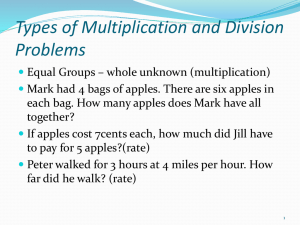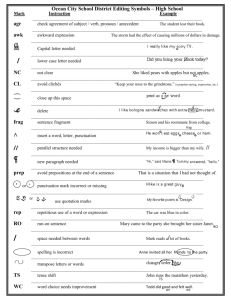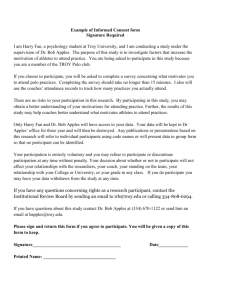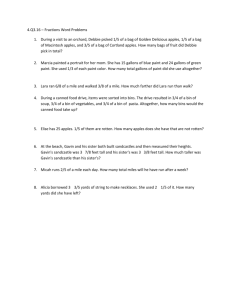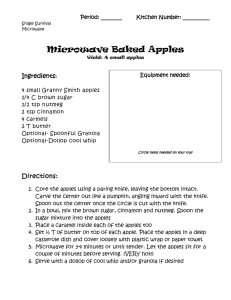contextual word problems - Math-4326
advertisement
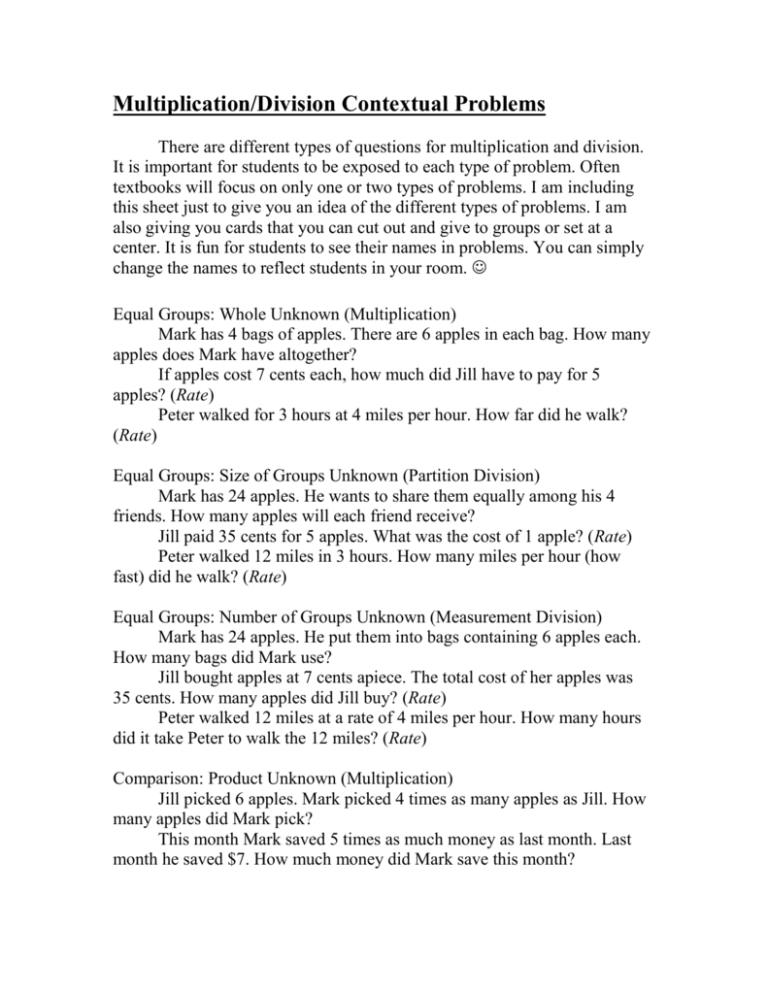
Multiplication/Division Contextual Problems There are different types of questions for multiplication and division. It is important for students to be exposed to each type of problem. Often textbooks will focus on only one or two types of problems. I am including this sheet just to give you an idea of the different types of problems. I am also giving you cards that you can cut out and give to groups or set at a center. It is fun for students to see their names in problems. You can simply change the names to reflect students in your room. Equal Groups: Whole Unknown (Multiplication) Mark has 4 bags of apples. There are 6 apples in each bag. How many apples does Mark have altogether? If apples cost 7 cents each, how much did Jill have to pay for 5 apples? (Rate) Peter walked for 3 hours at 4 miles per hour. How far did he walk? (Rate) Equal Groups: Size of Groups Unknown (Partition Division) Mark has 24 apples. He wants to share them equally among his 4 friends. How many apples will each friend receive? Jill paid 35 cents for 5 apples. What was the cost of 1 apple? (Rate) Peter walked 12 miles in 3 hours. How many miles per hour (how fast) did he walk? (Rate) Equal Groups: Number of Groups Unknown (Measurement Division) Mark has 24 apples. He put them into bags containing 6 apples each. How many bags did Mark use? Jill bought apples at 7 cents apiece. The total cost of her apples was 35 cents. How many apples did Jill buy? (Rate) Peter walked 12 miles at a rate of 4 miles per hour. How many hours did it take Peter to walk the 12 miles? (Rate) Comparison: Product Unknown (Multiplication) Jill picked 6 apples. Mark picked 4 times as many apples as Jill. How many apples did Mark pick? This month Mark saved 5 times as much money as last month. Last month he saved $7. How much money did Mark save this month? Comparison: Set Size Unknown (Partition Division) Mark picked 24 apples. He picked 4 times as many apples as Jill. How many apples did Jill pick? This month Mark saved 5 times as much money as he did last month. If he saved $35 this month, how much did he save last month? Comparison: Multiplier Unknown (Measurement Division) Mark picked 24 apples, and Jill picked only 6. How many times as many apples did Mark pick as Jill did? This month Mark saved $35. Last month he saved $7. How many times as much money did he save this month as last? Mark has 4 bags of apples. There are 6 apples in each bag. How many apples does Mark have altogether? If apples cost 7 cents each, how much did Jill have to pay for 5 apples? Peter walked for 3 hours at 4 miles per hour. How far did he walk? Mark has 24 Jill paid 35 cents for apples. He wants to 5 apples. What was share them equally the cost of 1 apple? among his 4 friends. How many apples will each friend receive? Peter walked 12 miles in 3 hours. How many miles per hour (how fast) did he walk? Mark has 24 apples. He put them into bags containing 6 apples each. How many bags did Mark use? Peter walked 12 miles at a rate of 4 miles per hour. How many hours did it take Peter to walk the 12 miles? Jill bought apples at 7 cents apiece. The total cost of her apples was 35 cents. How many apples did Jill buy? Jill picked 6 apples. Mark picked 4 times as many apples as Jill. How many apples did Mark pick? This month Mark saved 5 times as much money as last month. Last month he saved $7. How much money did Mark save this month? Mark picked 24 apples. He picked 4 times as many apples as Jill. How many apples did Jill pick? This month Mark saved 5 times as much money as he did last month. If he saved $35 this month, how much did he save last month? Mark picked 24 apples, and Jill picked only 6. How many times as many apples did Mark pick as Jill did? This month Mark saved $35. Last month he saved $7. How many times as much money did he save this month as last?


